View in other NatureServe Network Field Guides
NatureServe
Montana
Utah
Wyoming
Idaho
Wisconsin
British Columbia
South Carolina
Yukon
California
New York
Northwestern Jumping Mouse - Zapus saltator
Native Species
Global Rank:
GNR
State Rank:
S5
(see State Rank Reason below)
Agency Status
USFWS:
USFS:
BLM:
External Links
State Rank Reason (see State Rank above)
Species is common and widely distributed. It is likely stable and faces no known significant threats.
General Description
We do not yet have descriptive information on this species. Please try the buttons above to search for information from other sources.
Species Range
Montana Range
Range Descriptions
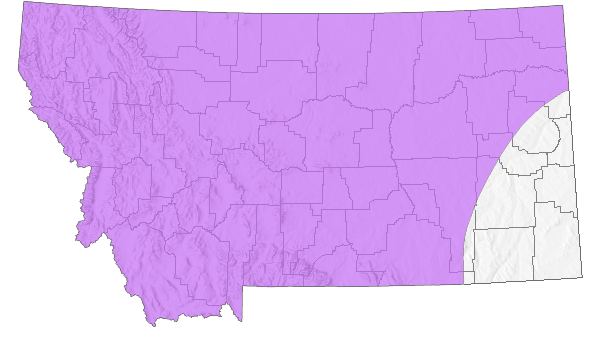
 Native
Native
Observations in Montana Natural Heritage Program Database
Number of Observations: 593
(Click on the following maps and charts to see full sized version)
Map Help and Descriptions
Relative Density
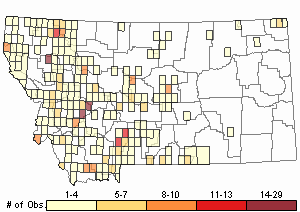
Recency
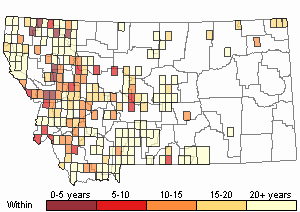
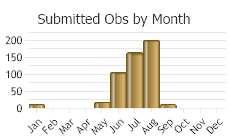
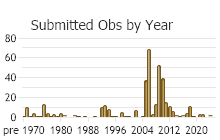
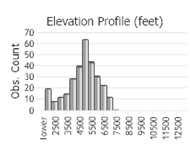 (Observations spanning multiple months or years are excluded from time charts)
(Observations spanning multiple months or years are excluded from time charts)
Migration
Non-migratory.
Habitat
Usually tall grass along streams, with or without a brush or tree canopy. Also dry grasslands in north-central MT. Mesic forests with sparse understory herbage in western MT. From valley floors to timberline and alpine wet sedge meadows (Hoffmann and Pattie 1968).
National Vegetation Classification System Groups Associated with this Species
Alpine
Alpine - Vegetated
Forest and Woodland
Deciduous Forest and Woodland
Low Elevation - Xeric Forest and Woodland
Montane - Subalpine Forest and Woodland
Shrubland
Arid - Saline Shrubland
Foothills - Montane Shrubland
Sagebrush Shrubland
Grassland
Lowland - Prairie Grassland
Montane - Subalpine Grassland
Wetland and Riparian
Alkaline - Saline Wetlands
Alpine Riparian and Wetland
Peatland
Riparian and Wetland Forest
Riparian Shrubland
Wet Meadow and Marsh
Recently Disturbed or Modified
Harvested Forest
Insect-Killed Forest
Introduced Vegetation
Human Land Use
Agriculture
Developed
Food Habits
Seeds are important pre-hibernation food. Accumulates fat reserves of up to 2/3 body weight. Does not cache food in or near winter nest (Jones et al. 1983).
Ecology
Nests are in mounds or banks elevated above surrounding ground (well-drained). Nests usually 2 feet underground, shredded vegetation insulative core. Single burrow 3 to 4 feet long. Entrance plugged (Jones et al. 1983).
Reproductive Characteristics
Young continue to nurse after they have begun eating solid food.
Stewardship Responsibility
References
- Literature Cited AboveLegend:
 View Online Publication
View Online Publication Hoffmann, R.S. and D.L. Pattie. 1968. A guide to Montana mammals: identification, habitat, distribution, and abundance. Missoula, MT: University of Montana. 133 p.
Hoffmann, R.S. and D.L. Pattie. 1968. A guide to Montana mammals: identification, habitat, distribution, and abundance. Missoula, MT: University of Montana. 133 p. Jones, J.K., D.M. Armstrong, R.S. Hoffmann and C. Jones. 1983. Mammals of the northern Great Plains. University of Nebraska Press, Lincoln. 379 pp.
Jones, J.K., D.M. Armstrong, R.S. Hoffmann and C. Jones. 1983. Mammals of the northern Great Plains. University of Nebraska Press, Lincoln. 379 pp.
- Additional ReferencesLegend:
 View Online Publication
View Online Publication
Do you know of a citation we're missing? [WWPC] Washington Water Power Company. 1995. 1994 wildlife report Noxon Rapids and Cabinet Gorge Reservoirs. Washington Water Power Company. Spokane, WA.
[WWPC] Washington Water Power Company. 1995. 1994 wildlife report Noxon Rapids and Cabinet Gorge Reservoirs. Washington Water Power Company. Spokane, WA. Adelman, E.B. 1979. A survey of the nongame mammals in the Upper Rattlesnake Creek drainage of western Montana. M.S. thesis. University of Montana, Missoula. 129 pp.
Adelman, E.B. 1979. A survey of the nongame mammals in the Upper Rattlesnake Creek drainage of western Montana. M.S. thesis. University of Montana, Missoula. 129 pp. Allen, K.L., T. Weaver, and D. Flath. 1994. Small mammals in Northern Rocky Mountain ecosystems. Unpubl. report to Bureau of Land Management and United States Forest Service, August 31, 1994. Montana State Univ., Bozeman. 54 pp.
Allen, K.L., T. Weaver, and D. Flath. 1994. Small mammals in Northern Rocky Mountain ecosystems. Unpubl. report to Bureau of Land Management and United States Forest Service, August 31, 1994. Montana State Univ., Bozeman. 54 pp. Anaconda Minerals Company, and Camp, Dresser & McKee. 1981. Anaconda Stillwater Project 6-month environmental baseline report. CDM Project No. 3139. Vol. I Appendix. Jan. 15, 1981.
Anaconda Minerals Company, and Camp, Dresser & McKee. 1981. Anaconda Stillwater Project 6-month environmental baseline report. CDM Project No. 3139. Vol. I Appendix. Jan. 15, 1981. Anderson, M.E. 1977. Aspects of the ecology of two sympatric species of Thamnophis and heavy metal accumulation with the species. M.S. thesis, University of Montana, Missoula. 147 pp.
Anderson, M.E. 1977. Aspects of the ecology of two sympatric species of Thamnophis and heavy metal accumulation with the species. M.S. thesis, University of Montana, Missoula. 147 pp. Bachen, D.A. 2014. Cheatgrass invasion of sagebrush steppe: Impacts of vegetation structure on small mammals. M.Sc. Thesis. Bozeman, Montana: Montana State University. 96 p.
Bachen, D.A. 2014. Cheatgrass invasion of sagebrush steppe: Impacts of vegetation structure on small mammals. M.Sc. Thesis. Bozeman, Montana: Montana State University. 96 p. Brown, L.N. 1967. Seasonal activity patterns and breeding of the western jumping mouse (Zapus princeps) in Wyoming. Am. Midl. Nat. 78(2):460-470.
Brown, L.N. 1967. Seasonal activity patterns and breeding of the western jumping mouse (Zapus princeps) in Wyoming. Am. Midl. Nat. 78(2):460-470. Brown, L.N. 1970. Population dynamics of the western jumping mouse (Zapus princeps) during a four-year study. J. Mammal. 51(4):651-658.
Brown, L.N. 1970. Population dynamics of the western jumping mouse (Zapus princeps) during a four-year study. J. Mammal. 51(4):651-658. Burnett, G.W. 1981. Movements and habitat use of American Marten in Glacier National Park, Montana. M.S. Thesis. University of Montana. Missoula. 130 pp.
Burnett, G.W. 1981. Movements and habitat use of American Marten in Glacier National Park, Montana. M.S. Thesis. University of Montana. Missoula. 130 pp. Clark, S.G. and M.R. Stromberg. 1987. Mammals in Wyoming. University of Kansas Museum of Natural History, Public Education Series Number 10. xii + 314 pp.
Clark, S.G. and M.R. Stromberg. 1987. Mammals in Wyoming. University of Kansas Museum of Natural History, Public Education Series Number 10. xii + 314 pp. Clark, T.W. 1971. Ecology of the western jumping mouse in Grand Teton National Park, Wyoming. Northwest Sci. 45:229-238.
Clark, T.W. 1971. Ecology of the western jumping mouse in Grand Teton National Park, Wyoming. Northwest Sci. 45:229-238. Coffin, K.W. 1994. Population characteristics and winter habitat selection by pine marten in southwest Montana. M.Sc. Thesis. Bozeman, MT: Montana State University. 94 p.
Coffin, K.W. 1994. Population characteristics and winter habitat selection by pine marten in southwest Montana. M.Sc. Thesis. Bozeman, MT: Montana State University. 94 p. Craighead, A.C. 2000. Pellet and scat analysis as indicators of present and past habitats. M.Sc. Theses. Bozeman, MT: Montana State University. 219 p.
Craighead, A.C. 2000. Pellet and scat analysis as indicators of present and past habitats. M.Sc. Theses. Bozeman, MT: Montana State University. 219 p. Cramer, P.C. 1992. Small mammal diversity and abundance in Douglas Fir old growth forests. M.Sc. Thesis. Bozeman, MT: Montana State University. 64 p.
Cramer, P.C. 1992. Small mammal diversity and abundance in Douglas Fir old growth forests. M.Sc. Thesis. Bozeman, MT: Montana State University. 64 p. Cranford, J.A. 1983. Ecological strategies of a small hibernator, the western jumping mouse Zapus princeps. Canadian Journal of Zoology 61:232-240.
Cranford, J.A. 1983. Ecological strategies of a small hibernator, the western jumping mouse Zapus princeps. Canadian Journal of Zoology 61:232-240. Davis, W.B. 1937. Some mammals from western Montana and eastern Idaho. The Murrelet 18(2): 22-27.
Davis, W.B. 1937. Some mammals from western Montana and eastern Idaho. The Murrelet 18(2): 22-27. Dice, L.R. 1923. Mammal associations and habitats of the Flathead Lake Region, Montana. Ecology 4(3): 247-260.
Dice, L.R. 1923. Mammal associations and habitats of the Flathead Lake Region, Montana. Ecology 4(3): 247-260. Eng, R.L. 1976. Wildlife Baseline Study [for West Fork of the Stillwater and Picket Pin drainages]
Eng, R.L. 1976. Wildlife Baseline Study [for West Fork of the Stillwater and Picket Pin drainages] Falk, J.W. and J.S. Millar. 1987. Reproduction by female Zapus priceps in relation to age, size, and body fat. Canadian Journal of Zoology 65:568-571.
Falk, J.W. and J.S. Millar. 1987. Reproduction by female Zapus priceps in relation to age, size, and body fat. Canadian Journal of Zoology 65:568-571. Feigley, H.P. 1981. Studies on native small mammals as intermediate hosts of Echinococcus multilocularis. M.Sc. Thesis. Bozeman, Montana: Montana State University. 50 p.
Feigley, H.P. 1981. Studies on native small mammals as intermediate hosts of Echinococcus multilocularis. M.Sc. Thesis. Bozeman, Montana: Montana State University. 50 p. Fjell, Alan K., and Brian R. Mahan, compilers., 1984, Peabody Coal Company Big Sky Mine, Rosebud County, MT. Wildlife monitoring report: 1983 field season. February 1984.
Fjell, Alan K., and Brian R. Mahan, compilers., 1984, Peabody Coal Company Big Sky Mine, Rosebud County, MT. Wildlife monitoring report: 1983 field season. February 1984. Foresman, K.R. 2001. The wild mammals of Montana. American Society of Mammalogists, Special Publication Number 12. Lawrence, KS. 278 pp.
Foresman, K.R. 2001. The wild mammals of Montana. American Society of Mammalogists, Special Publication Number 12. Lawrence, KS. 278 pp. Foresman, K.R. 2012. Mammals of Montana. Second edition. Mountain Press Publishing, Missoula, Montana. 429 pp.
Foresman, K.R. 2012. Mammals of Montana. Second edition. Mountain Press Publishing, Missoula, Montana. 429 pp. Haglund, B.M. 1972. Ecological effects of weather modification, Bangtail Ridge, Bridger Range, Montana: relationships of pocket gophers (Thomomys talpoides) to time of snow melt. M.Sc. Thesis. Bozeman, Montana: Montana State University. 26 p.
Haglund, B.M. 1972. Ecological effects of weather modification, Bangtail Ridge, Bridger Range, Montana: relationships of pocket gophers (Thomomys talpoides) to time of snow melt. M.Sc. Thesis. Bozeman, Montana: Montana State University. 26 p. Hanauska-Brown, L., B.A. Maxell, A. Petersen, and S. Story. 2014. Diversity Monitoring in Montana 2008-2010 Final Report. Montana Fish, Wildlife & Parks. Helena, MT. 78 pp.
Hanauska-Brown, L., B.A. Maxell, A. Petersen, and S. Story. 2014. Diversity Monitoring in Montana 2008-2010 Final Report. Montana Fish, Wildlife & Parks. Helena, MT. 78 pp. Hart, E. B., M. C. Belk, E. Jordan and M. W. Gonzalez. 2004. Zapus princeps. American Society of Mammalogists, Lawrence, KS. Mammalian Species No. 749:1-7.
Hart, E. B., M. C. Belk, E. Jordan and M. W. Gonzalez. 2004. Zapus princeps. American Society of Mammalogists, Lawrence, KS. Mammalian Species No. 749:1-7. Hawley, V.D. 1955. The ecology of the marten in Glacier National Park. M.S. thesis. University of Montana, Missoula. 131 pp.
Hawley, V.D. 1955. The ecology of the marten in Glacier National Park. M.S. thesis. University of Montana, Missoula. 131 pp. Hayward, G. D. and P. H. Hayward. 1995. Relative abundance and habitat associations of small mammals in the Chamberlain Basin, central Idaho. Northwest Sci. 69(2): 114-125.
Hayward, G. D. and P. H. Hayward. 1995. Relative abundance and habitat associations of small mammals in the Chamberlain Basin, central Idaho. Northwest Sci. 69(2): 114-125. Heath, M.L. 1973. Small mammal populations in clearcuts of various ages in south central Montana. M.Sc. Thesis. Bozeman, Montana: Montana State University. 33 p.
Heath, M.L. 1973. Small mammal populations in clearcuts of various ages in south central Montana. M.Sc. Thesis. Bozeman, Montana: Montana State University. 33 p. Hendricks, P., S. Lenard, D.M. Stagliano, and B.A. Maxell. 2013. Baseline nongame wildlife surveys on the Fort Peck Indian Reservation. Report to the Assiniboine and Sioux Tribes of the Fort Peck Indian Reservation. Montana Natural Heritage Program, Helena, MT. 83 p.
Hendricks, P., S. Lenard, D.M. Stagliano, and B.A. Maxell. 2013. Baseline nongame wildlife surveys on the Fort Peck Indian Reservation. Report to the Assiniboine and Sioux Tribes of the Fort Peck Indian Reservation. Montana Natural Heritage Program, Helena, MT. 83 p. Hodgson, J.R. 1970. Ecological distribution of Microtus montanus and Microtus pennsylvanicus in an area of geographic sympatry in southwestern Montana. Ph.D. Dissertation. Bozeman, Montana: Montana State University. 65 p.
Hodgson, J.R. 1970. Ecological distribution of Microtus montanus and Microtus pennsylvanicus in an area of geographic sympatry in southwestern Montana. Ph.D. Dissertation. Bozeman, Montana: Montana State University. 65 p. Johnson, L.J. 1960. Mammal studies on the Lubrecht Forest, Montana: a preliminary report. Proc. Mont. Acad. Sci. 20: 40-47.
Johnson, L.J. 1960. Mammal studies on the Lubrecht Forest, Montana: a preliminary report. Proc. Mont. Acad. Sci. 20: 40-47. Joslin, Gayle, and Heidi B. Youmans. 1999. Effects of recreation on Rocky Mountain wildlife: a review for Montana. [Montana]: Montana Chapter of the Wildlife Society.
Joslin, Gayle, and Heidi B. Youmans. 1999. Effects of recreation on Rocky Mountain wildlife: a review for Montana. [Montana]: Montana Chapter of the Wildlife Society. Key, C.H. 1979. Mammalian utilization of floodplain habitats along the North Fork of the Flathead River in Glacier National Park, Montana. M.S. thesis. University of Montana, Missoula.
Key, C.H. 1979. Mammalian utilization of floodplain habitats along the North Fork of the Flathead River in Glacier National Park, Montana. M.S. thesis. University of Montana, Missoula. Klaus, M. 1997. Dispersal of Microtus richardsoni in the Beartooth Mountains of Montana and Wyoming. Ph.D. Dissertation. Bozeman, MT: Montana State University. 56 p.
Klaus, M. 1997. Dispersal of Microtus richardsoni in the Beartooth Mountains of Montana and Wyoming. Ph.D. Dissertation. Bozeman, MT: Montana State University. 56 p. Kritzman, E.B. 1977. Little mammals of the Pacific Northwest. Pacific Search Press, Seattle, WA.
Kritzman, E.B. 1977. Little mammals of the Pacific Northwest. Pacific Search Press, Seattle, WA. Luoma, S. N. 1969. A study of hibernation in the western jumping mouse, Zapus princeps. M.S. thesis, Montata State University. 39 pp.
Luoma, S. N. 1969. A study of hibernation in the western jumping mouse, Zapus princeps. M.S. thesis, Montata State University. 39 pp. Northrop, Devine & Tarbell, Inc. 1994. Cabinet Gorge and Noxon Rapids hydroelectric developments: 1993 wildlife study. Unpublished report to the Washington Water Power Company, Spokane. Vancouver, Washington and Portland, Maine. 144 pp. plus appendices.
Northrop, Devine & Tarbell, Inc. 1994. Cabinet Gorge and Noxon Rapids hydroelectric developments: 1993 wildlife study. Unpublished report to the Washington Water Power Company, Spokane. Vancouver, Washington and Portland, Maine. 144 pp. plus appendices. Oechsli, L.M. 2000. Ex-urban development in the Rocky Mountain West: consequences for native vegetation, wildlife diversity, and land-use planning in Big Sky, Montana. M.Sc. Thesis. Montana State University, Bozeman. 73 p.
Oechsli, L.M. 2000. Ex-urban development in the Rocky Mountain West: consequences for native vegetation, wildlife diversity, and land-use planning in Big Sky, Montana. M.Sc. Thesis. Montana State University, Bozeman. 73 p. Pattie, D.L. and N.A. M. Verbeek. 1967. Alpine mammals of the Beartooth Plateau. Northwest Science 41(3): 110-117.
Pattie, D.L. and N.A. M. Verbeek. 1967. Alpine mammals of the Beartooth Plateau. Northwest Science 41(3): 110-117. Plopper, C.E. 1968. Insular and mainland populations of Peromyscus maniculatus at Flathead Lake, Montana. M.S. thesis. University of Montana, Missoula. 91 pp.
Plopper, C.E. 1968. Insular and mainland populations of Peromyscus maniculatus at Flathead Lake, Montana. M.S. thesis. University of Montana, Missoula. 91 pp. Ramirez, Pedro, Jr. 1977. Small Populations in Different-Aged Clearcuts and Uncut Forests in Northwestern Montana. M. S. thesis. 72 pp.
Ramirez, Pedro, Jr. 1977. Small Populations in Different-Aged Clearcuts and Uncut Forests in Northwestern Montana. M. S. thesis. 72 pp. Reichel, J.D. 1996. Northern bog lemming survey: 1995: Garnet Resource Area. Montana Natural Heritage Program. Helena, MT. 35 pp.
Reichel, J.D. 1996. Northern bog lemming survey: 1995: Garnet Resource Area. Montana Natural Heritage Program. Helena, MT. 35 pp. Reichel, J.D. and S.G. Beckstrom. 1993. Northern bog lemming survey: 1992. Unpublished report. Montana Natural Heritage Program, Helena, MT. 64 p.
Reichel, J.D. and S.G. Beckstrom. 1993. Northern bog lemming survey: 1992. Unpublished report. Montana Natural Heritage Program, Helena, MT. 64 p. Reichel, J.D. and S.G. Beckstrom. 1994. Northern bog lemming survey: 1993. Unpublished report. Montana Natural Heritage Program. Helena, MT. 87 pp.
Reichel, J.D. and S.G. Beckstrom. 1994. Northern bog lemming survey: 1993. Unpublished report. Montana Natural Heritage Program. Helena, MT. 87 pp. Reid, F. 2006. Peterson Field Guide to Mammals of North America, 4th Edition. Houghton Mifflin Company: Boston and New York, 608 pp.
Reid, F. 2006. Peterson Field Guide to Mammals of North America, 4th Edition. Houghton Mifflin Company: Boston and New York, 608 pp. Russell, R. J. and S. Anderson. 1956. Small mammals from Silver Bow County, Montana. Murrelet 37:2-3.
Russell, R. J. and S. Anderson. 1956. Small mammals from Silver Bow County, Montana. Murrelet 37:2-3. Rust, H. J. 1946. Mammals of northern Idaho. J. Mammal. 27(4): 308-327.
Rust, H. J. 1946. Mammals of northern Idaho. J. Mammal. 27(4): 308-327. Sawyer, H. E. 1935. Studies on the rodents of Montana. M.A. thesis. University of Montana, Missoula. 111 pp.
Sawyer, H. E. 1935. Studies on the rodents of Montana. M.A. thesis. University of Montana, Missoula. 111 pp. Stearns-Roger Inc., 1975, Environmental baseline information of the Mount Vernon Region, Montana. January 31, 1975.
Stearns-Roger Inc., 1975, Environmental baseline information of the Mount Vernon Region, Montana. January 31, 1975. Stoecker, R.E. 1967. A population study of five species of small rodents in the Bridger Mountains of Montana. M.Sc. Thesis. Bozeman, Montana: Montana State University. 32 p.
Stoecker, R.E. 1967. A population study of five species of small rodents in the Bridger Mountains of Montana. M.Sc. Thesis. Bozeman, Montana: Montana State University. 32 p. Thompson, L.S. 1982. Distribution of Montana amphibians, reptiles, and mammals. Bozeman: Montana Audubon Council. 24 pp.
Thompson, L.S. 1982. Distribution of Montana amphibians, reptiles, and mammals. Bozeman: Montana Audubon Council. 24 pp. Thompson, Richard W., Western Resource Dev. Corp., Boulder, CO., 1996, Wildlife baseline report for the Montana [Montanore] Project, Lincoln and Sanders counties, Montana. In Application for a Hard Rock Operating Permit and Proposed Plan of Operation, Montanore Project, Lincoln and Sanders Counties, Montana. Vol. 5. Stroiazzo, John. Noranda Minerals Corp., Libby, MT. Revised September 1996.
Thompson, Richard W., Western Resource Dev. Corp., Boulder, CO., 1996, Wildlife baseline report for the Montana [Montanore] Project, Lincoln and Sanders counties, Montana. In Application for a Hard Rock Operating Permit and Proposed Plan of Operation, Montanore Project, Lincoln and Sanders Counties, Montana. Vol. 5. Stroiazzo, John. Noranda Minerals Corp., Libby, MT. Revised September 1996. Tweten, R.G. 1984. Baseline survey of furbearing mammals within the South Fork drainage Sun River, Montana. M.Sc. Thesis. Bozeman, MT: Montana State University. 63 p.
Tweten, R.G. 1984. Baseline survey of furbearing mammals within the South Fork drainage Sun River, Montana. M.Sc. Thesis. Bozeman, MT: Montana State University. 63 p. Von Gunten. 1978. Pronghorn fawn mortality on the National Bison Range. M.S. thesis. University of Montana, Missoula. 82 pp.
Von Gunten. 1978. Pronghorn fawn mortality on the National Bison Range. M.S. thesis. University of Montana, Missoula. 82 pp. Weckwerth, R.P. 1957. The relationship between the marten population and the abundance of small mammals in Glacier National Park. M.S. thesis. University of Montana, Missoula. 76 pp.
Weckwerth, R.P. 1957. The relationship between the marten population and the abundance of small mammals in Glacier National Park. M.S. thesis. University of Montana, Missoula. 76 pp. Williams, O. 1955. Distribution of mice and shrews in a Colorado montane forest. J. Mammal. 36(2): 221-231.
Williams, O. 1955. Distribution of mice and shrews in a Colorado montane forest. J. Mammal. 36(2): 221-231. Wood, M.A. 1981. Small mammal communities after two recent fires in Yellowstone National Park. M.Sc. Thesis. Bozeman, Montana: Montana State University. 58 p.
Wood, M.A. 1981. Small mammal communities after two recent fires in Yellowstone National Park. M.Sc. Thesis. Bozeman, Montana: Montana State University. 58 p.
- Web Search Engines for Articles on "Northwestern Jumping Mouse"
- Additional Sources of Information Related to "Mammals"





